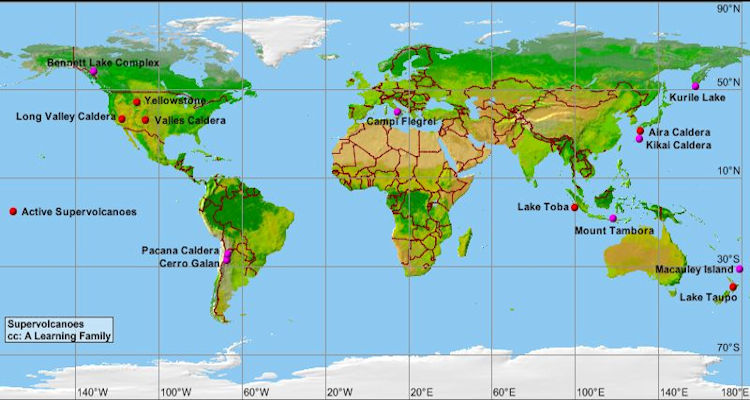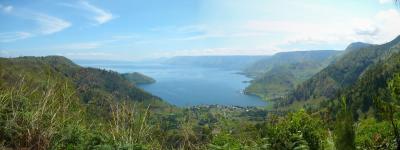Supervolcanoes are usually not on your radar unless you’ve got a special interest in them. If you’re in North America, more than likely the supervolcanoes that are within your awareness include Yellowstone, Valles Caldera, and Long Valley Caldera. If you’re in Europe, Campi Flegrei in Italy would more likely be of interest. And if you’re in Australia or New Zealand, more than likely you’ve heard Lake Taupo been talked about as a supervolcano in the region.

But what about SouthEast Asia? If you haven’t heard of Lake Toba, you soon will. Located on the island of Sumatra, in Indonesia, Lake Toba is a beautiful caldera lake, measuring 100 km by 30 km. Its odd elongate shape is a result of the interactions between the magma chamber and the shearing forces of the Sumatran Fault along the west that has stretched it out. In the center of Lake Toba is an island called Samosir Island. According to the local legend, the formation of Lake Toba is as follows: (excerpt from Indonesian Folktales Wiki)
“…Once upon a time there was a young farmer whose name was Toba. He lived in a valley which land was fertile, therefore he was able support his life by the crops he grew although he was not a rich man.
One day, he felt like to eat fish so he went fishing at a river not far from his house. The river was usually rich with fish, but on that strange day he did not catch any fish for a long time, so he decided to just went home. Just as he was preparing to leave, his rod caught a big fish. As he lifted the fish, it suddenly talked. The fish cried and begged him to release it.
pic_a26918b5b8b196f61bc2d4afaa6da537.jpg
Toba catching the fish (Image from superkidsindonesia.com)Surprised to see a talking fish, he released it to the river, but suddenly the fish transformed into beautiful young woman. The young woman said that she was actually a princess cursed to be a fish. She thanked the young farmer for breaking her curse and to show her gratitude, she was willing to be his wife under the condition that the farmer should not tell anybody about her being a fish once or a terrible disaster would be fallen on him. So the farmer and the woman got married and after a while the woman gave birth to a baby boy. The boy grew up to be a child of great appetite. He was always hungry and would eat all the food at the table and would not even leave any food for his parents to eat.
One day the boy was asked to bring food to his father who was working on the field. But on the way, the boy ate up the food he carried. At the field, his father was very hungry and tired after working, but he found out there was no food left for him to eat. This made the farmer lost his temper and in anger, he hit the boy and called him a son of the fish.
Crying, the boy ran home and asked his mother if he really was a son of a fish. Shocked and sad to hear that, his mother told the boy to climb to the hill near their house and to climb to the top of the tallest tree. She herself hurried up to the river where he met the young farmer the first time and disappeared.
danau_toba3.jpg
The boy crying to his mother (Image from ceritawayangbahasajawa.blogspot.com)The sky turned black and thunder and lightning roared and heavy rain fell onto the valley. The rain was so hard and so long that the valley began to be flooded. The water got higher and higher until the valley was no more. It had turned into a lake. People named the lake after the farmer, Toba. The hill became an island in the middle of the lake, and it was named Samosir Island. The son was believed to be the ancestor of Batak People of North Sumatera.”

It is quite an interesting story especially as origin stories go. But how did geologists think Lake Toba formed? Well, what we see at Toba is actually a result of 4 huge eruptions imprinted one on top of the other. The first eruption was around 1.2 million years ago. Before this, it was likely that the land was slightly bulging over a huge area, as a result of the magma chamber building underneath. Since we haven’t seen a supervolcanic eruption within our lifetime, it is hard to say what the surface looks like before a supervolcanic eruption and whether there was a ‘mountain’ feature that blew its top.

HDT is the 1.2 million year old eruption, followed by OTT at 0.8 million years old, MTT at 0.5 million years old, and finally YTT at 74-75 thousand years ago.
This first eruption left a big depression in the ground, a caldera, and the subsequent two eruptions, at 0.8 million years ago and 0.5 million years ago, just enlarged the depression. The most recent eruption was around 74 thousand years ago, created the large caldera depression that we see today (that has since filled up with rainwater and runoff to form the lake) and produced a massive outflow of ash and rock and debris, known as ignimbrite. This 74 thousand year old ignimbrite has since been named the Youngest Toba Tuff (or YTT) and is one of the most widely studied ignimbrites in the volcanology field.


What is of particular interest, especially at Oregon State University (OSU, home of VolcanoWorld), is what happened after the caldera was created. Today we see Samosir Island in the middle of the lake. How did it get there?
Studies of several large caldera systems in the world have shown that after the big catastrophic caldera-forming eruption, something goes on underground, where the magma chamber used to be. Whether it’s old magma that is reactivated or something else, something happens that actually pushes the floor of the caldera up. In the case for Toba, it pushed the floor all the way up until it rose above lake level, forming Samosir Island. This whole process is known as resurgence and is the topic of ongoing research at OSU.
Toba is still considered to be in this stage of resurgence (either in the middle or at the end of this process). It is very likely that this process of resurgence is linked to reactivated faults (forming earthquakes) and localized volcanic eruptions, which can pose a hazard to people living in and around Toba. As a result, studying Toba’s resurgence is a point of interest among the volcanologists at OSU. Check out the video below for a cool animation of the whole caldera forming and resurgent process at Toba!